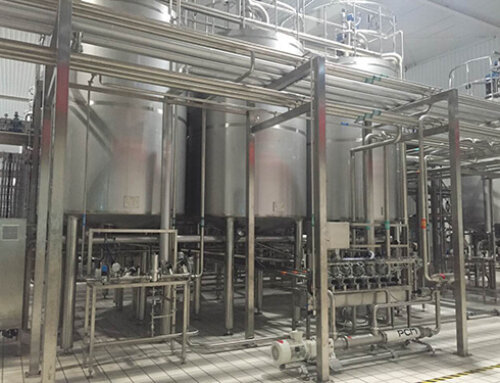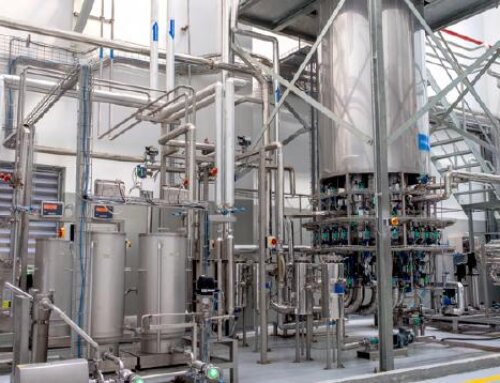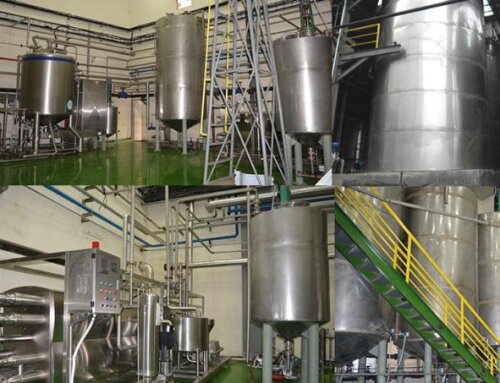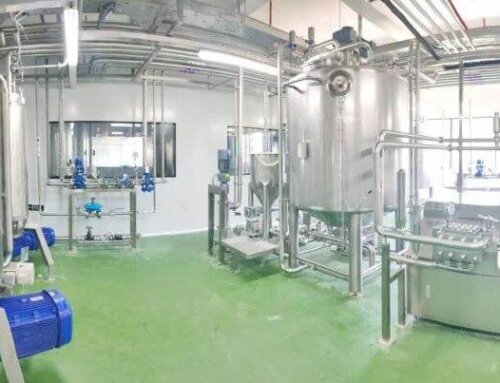Description Of Beverage Production Plant
- Flavored beverages are classified as flavored beverages when the characteristic ingredients in certain beverages fail to meet the requirements of other beverages. Such beverages are allowed to be formulated with only edible flavors.
- The beverage production investment is small, the production cycle is short, and the profits are high. With the improvement of people’s living standards, flavored beverages are also developing towards nutrition and diversification.
- The beverages are made from edible flavors, juice, plant extracts, spices, white sugar, sweeteners, and sour agents as the main methods to adjust the flavor of the drinks, then after sterilizing, filled into consumable containers.
- The beverage production plant is mainly composed of flavor ingredients dissolving system, beverage blending/mixing system, flavored beverage filtration, homogenization, sterilization system, filling and post-packaging system, CIP system and RO water treatment system. The production capacity of the equipment is from 500L/H to 10000L/H for users to choose from, and the final product can be filled into PET bottles or tin cans and carton containers.
- There are mainly two flavor substances in flavored beverage production: natural flavors and synthetic flavors. Natural flavor substances are flavor ingredients that are processed from plant products or some animal products for people to use. The processing of flavor substances mainly includes extraction and distillation to obtain natural concentrates before application; Synthetic flavor substances are mainly separated from aromatic raw materials by chemical methods, which are characterized by the same chemical properties as natural flavor substances, and can be used directly or indirectly.
Beverage Production Plant Classification
Fruit-flavored beverages: Beverages prepared from sugar, sweeteners, sour agents, fruit juices, edible flavors, tea or vegetable oil extracts, etc., and the content of the original fruit juice in the final product is less than 5%. Such as apple-flavored drinks, orange-flavored drinks, lemon-flavored drinks.
Milk-flavored beverages: Made from sugar, sweeteners, sour agents, fruit juices, edible flavors, tea or vegetable oil extracts, etc., with milk protein content <1.0%, or fermented milk protein content < 0.7%.
Tea-flavored beverages: Beverages with tea or tea essence as the main aroma component and tea polyphenol content <100mg/kg.
Coffee-flavored beverages: Beverages with coffee or coffee essence as the main flavoring ingredient, but the caffeine content does not meet the requirements of coffee beverages.
Enzyme beverage: Enzyme beverages refer to beverages that must contain a variety of enzyme metabolites created from a huge group of enzymes derived from plants and microorganisms. The enzyme beverage production line adopts traditional fermentation technology, and the fermentation process is divided into three stages: yeast fermentation, acetic acid bacteria fermentation and lactic acid bacteria fermentation.
The first stage: yeast fermentation – the yeast fermentation stage decomposes macromolecules into small molecules, and decomposes starch into carbon dioxide and alcohol, also called saccharification.
The second stage: acetic acid bacteria fermentation – the acetic acid bacteria fermentation stage decomposes the alcohol, this stage is also called vinegarification.
Three stages: lactic acid bacteria fermentation – lactic acid bacteria fermentation stage lactic acid produces probiotics under the action of counteracting, this stage is also called maturation.

Beverage Production Plant Key Process Introduction
Raw materials selecting
In flavored beverages, sugar is the main ingredient, sugar serves primarily as a preservative to prevent the beverages from oxidization, sugar also has the effect of helping hold the color and flavor in drinks. Commonly used sour agents are citric acid, tartaric acid, apple acids, phosphoric and lactic acids, citric acid is the most widely used, and sour agents can greatly enhance the flavor of the beverage. In addition, there are fruit juice, milk, coffee extract, tea extract, other plant extracts, other sweeteners, flavors, colors, etc., as well as preservatives, antioxidants and stabilizers.
Beverage blending and preparation
Blending is a key process for beverages processing. First, pump a certain amount of filtered raw syrup into the mixing tank, add various ingredients in sequence according to the proportion under constant stirring, and finally add purified water to the specified volume. When preparing, pay attention to the dissolution of ingredients.
- Additives with high viscosity such as emulsifiers and stabilizers need to be soaked in warm water and then stirred with a mixer to fully dissolve them and then added to the prepared syrup in the mixing tank.
- First dilute the citric acid to a solution with a content of less than 5%, then add it into the cooled mixing tank by spraying, and continuously stirring it into the sugar liquid. According to the different characteristics of the product, adjust the PH value to an appropriate value.
- The colorant should also be diluted in water before adding, and the concentration should be added slowly from low to high.
- Volatile flavors are best added after the flavored beverage has been homogenized and sterilized.

Beverage homogenization, sterilization, filling system
In beverage production, homogenization, degassing, and sterilization are crucial processes for improving product consistency, shelf life, and safety. Each step serves a specific purpose and is often part of an integrated system used in the production of all kinds of beverages. Here’s a breakdown of each process:
The prepared beverage is homogenized under the conditions of 50-70°C and 15-30Mpa, so that various nutritional components are homogenized, and the product stability is further improved.
During degassing, the liquid is fed into a vacuum degassing tank, which pulls dissolved gases out of the beverage through the vacuum pump. The degassing process prevents beverage oxidation to extend the shelf life and reduce foam during the filling process.
According to the component characteristics and PH value of flavored beverages, different sterilization processes can be selected. Generally, high-temperature short-time sterilization and ultra-high-temperature instantaneous sterilization process are used. Fill and seal the homogenized material liquid into containers, sterilize it at 100-120℃ for 15-20min, cool to room temperature for packaging, or sterilize the flavored beverage at 130-140℃ for 3-4S, then fill into containers, Cool to room temperature for packaging.
- In modern beverage manufacturing, homogenization, degassing, and sterilization are often part of a continuous processing line, especially in large-scale production facilities.
- The liquid is first homogenized to ensure a uniform consistency, followed by degassing to remove any dissolved gases. Finally, the beverage undergoes sterilization to eliminate harmful bacteria and ensure a long shelf life.
- These systems are typically automated and designed to operate under strict hygienic conditions to meet food safety standards.

Quality Control of Beverages Production Plant
The characteristic flavor is not obvious: Insufficient addition of flavored beverage extracts or volatile flavor components, resulting in inconspicuous product flavors, strict requirements for raw material quality and ingredient control are required in production.
Beverage stale: Some natural flavor substances are unstable and will stale with prolonged storage time; sometimes the flavored beverages will become stale due to improper operation during the production process. If the product is contaminated by microorganisms, it will have a sour taste; the quality of the essence is poor, and improper use will cause peculiar smell. ; Excessive citric acid will cause astringency, and unwashed recycling bottles will cause various odors. To solve these problems, it is necessary to strengthen the management and control of water treatment, quality of raw and auxiliary materials, ingredients, bottle washing, filling, sterilization and cleaning and disinfection of other packaging containers, and strengthen the hygiene management of operators.




